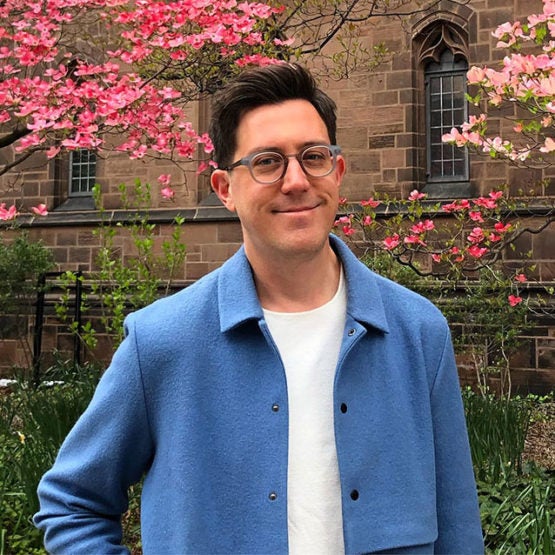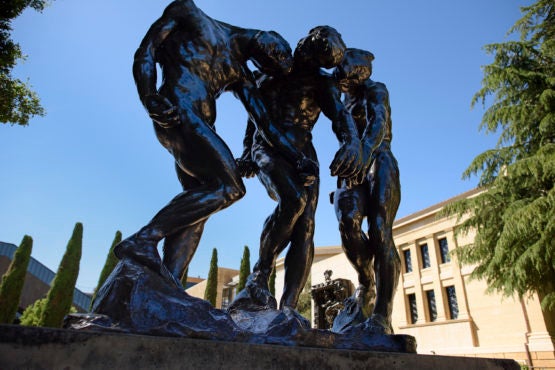What makes a Rodin ‘a Rodin’? Stanford scholar explains the famed sculptor’s process
The Cantor Art Center’s extensive collection of the artist’s sculptures invoke contemporary questions across disciplines.
In recent days, an announcement by the Musée Rodin in Paris to use Auguste Rodin’s molds to produce additional sculptures of his work as a fundraising tool raised questions about multiplicity, authorship and how cultural institutions should weather financial challenges like those resulting from the coronavirus pandemic.
When Rodin died in 1917, he bequeathed not only his work to the Musée Rodin in Paris, but also authorization to produce and sell up to 12 bronze sculptures from each of some 7,000 molds. In the decades since, the museum utilized only a small portion of molds to produce works considered to be original editions; as such, casts for many of the artist’s best known sculptures, such as The Thinker, have already been employed their maximum allowed times.

Patrick Crowley is associate curator of European art at the Cantor Arts Center. (Image credit: Seth Estrin)
Stanford University’s extensive collection of Rodin’s works, one of the largest anywhere, is a favorite of visitors to campus as well as students and faculty across disciplines. His Burghers of Calais in Memorial Court and 20 works in the Rodin Sculpture Garden, adjacent to the Cantor Arts Center, remain accessible to the public 24 hours a day when many educational offerings are temporarily closed.
In addition to providing lessons about the expressive capacity of the human form, these works offer a case study for considering topics about replication as conspicuous today as when Rodin introduced inventive means of artistic practice in the late 19th century. In the context of current headlines, Cantor associate curator of European art Patrick “Patch” R. Crowley helps unpack Rodin’s approach and how his legacy endures in ways that extend beyond his art.
What makes Rodin’s sculptures “modern”?
The enduring appeal of Rodin, the modernity of his work, has to do with the way in which he makes visible an aesthetic of process – how, in other words, he takes traditional sculpture apart and puts it back together again in new and daring ways. Strategies of multiplication, scalability, fragmentation and recombinatory modes of assembly and display constitute some of the hallmarks of Rodin’s artistic practice.

The Three Shades is among the works in the Rodin Sculpture Garden, adjacent to the Cantor Arts Center. The sculpture uses three separate casts of the same figure that has been rotated into different positions. (Image credit: L.A. Cicero)
How does Rodin’s work illuminate issues of authorship?
Like other sculptors of his time, Rodin never went to the foundry where his bronzes were actually cast, instead working primarily on the original models in clay as well as with plaster casts. Even most of his marble sculptures were made by assistants known as practiciens who would model them after the originals. Rodin wasn’t unique in this regard, but his prodigious body of work nevertheless invites us to think about issues of authorship and labor – in particular, the role of “fabricators,” as they are known today, who translate an artist’s vision into material form – that remain as timely as ever.
What is the relationship of the artist to the authorized production of editions of his work in present day?
Crucial to any question about what constitutes an “original” is the issue of medium. Bronze, for example, is a medium that is based on the very premise of reproducibility. In the case of Rodin, the chief criterion for what counts as an “original” is a legal one. Specialists refer to legally authorized originals taken from the original plasters as “editions” (set at 12 for Rodin); these are, in an oxymoronic sense, “original copies.” Any bronzes cast outside of this sanctioned process (e.g., bronzes cast from other casts, rather than the original plasters) are usually called “reproductions.” Rodin is by no means the first or the only artist to be caught up in such a dense thicket of legal and even philosophical questions about what makes an “original,” but he is probably the most well known and complex. Indeed, Rodin himself acutely recognized the importance of implementing such a system in order to posthumously control his legacy. Yet one consequence of this that has become particularly visible in the wake of the global pandemic is how this legacy has effectively been transformed into a robust financial instrument.
Works by Rodin on view at the Cantor are often utilized by students and scholars from a range of disciplines, including medicine. In this moment, with outbreak of disease across the globe, what can Rodin’s works teach us about the relationship between art and nature?
It’s interesting that Rodin attracts so much attention from medical experts, especially here at Stanford, who have used his hands for diagnostic purposes. It’s true that Rodin was intensely interested in exploring pathologies of the body, especially now-discredited understandings of female hysteria. But there is also the irony that Rodin became furious after a critic accused him of making his first life-size figure through life casting, rather than modeling it himself. It should go without saying, but Rodin’s hands are not hands – not real ones, anyway – and their expressive forms don’t align neatly with the anatomical reality of hands in flesh and blood or even their more naturalistic counterparts. But the very fact that they elicit such responses demonstrates the power of art to provoke challenging questions that drive innovative paths of research that cut across disciplines, particularly in a university setting.
More information about Rodin, casting and issues of originality is available in Crowley’s “Recasting Rodin,” a digital guide that is part of Learning From Home, an effort by the Cantor and Anderson Collection at Stanford University to provide remote resources in support of the academic community. Rodin: The Shock of the Modern Body, an exhibition featuring nearly 100 sculptures installed in celebration of the centenary of Rodin’s death, will be on view at the Cantor upon reopening.
